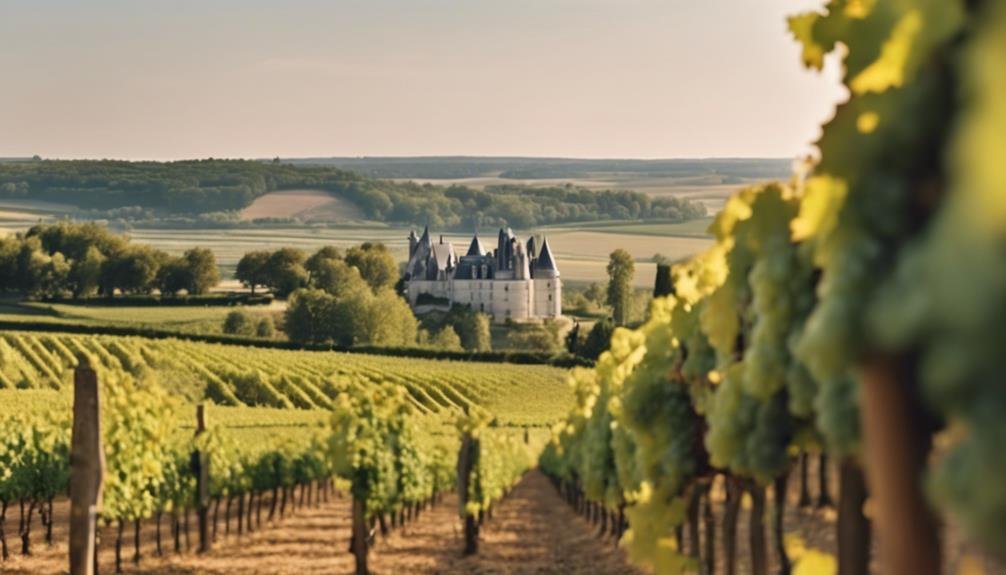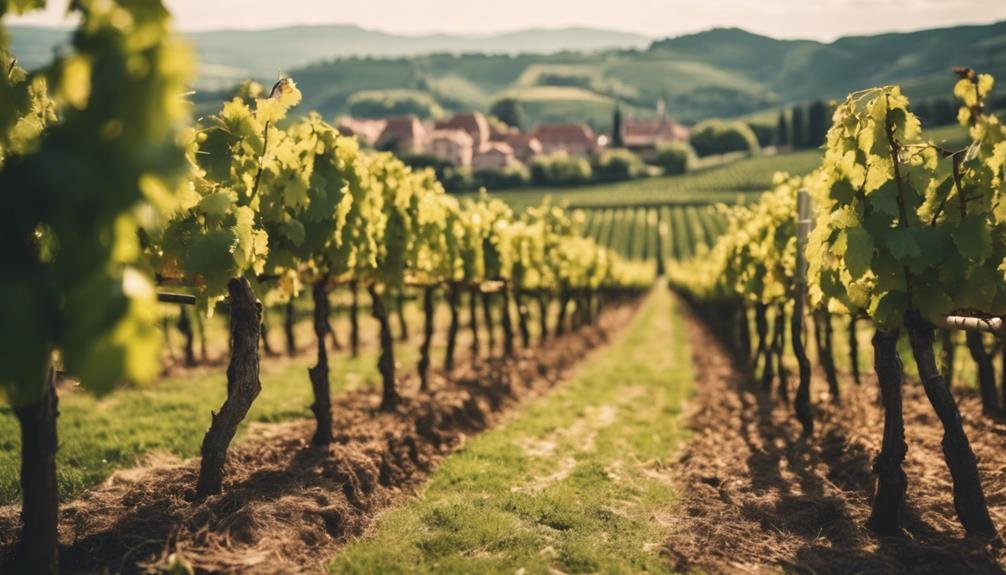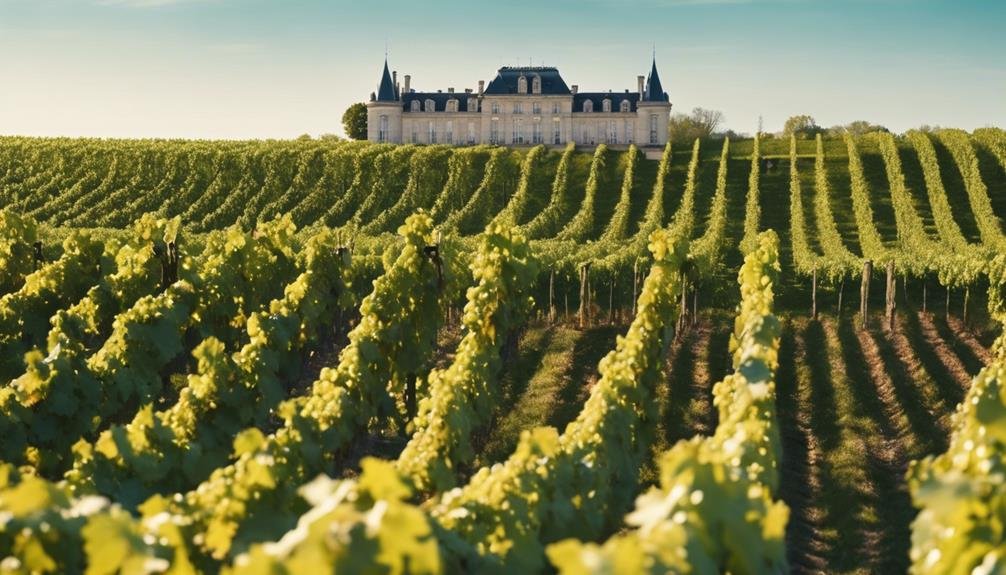Discover the charm of French bubbly regions on a sparkling journey. Champagne steals the spotlight, while Limoux may have kick-started sparkling wine production. With 23 regions to explore, unique bubbly delights await. Loire and Burgundy bubbles offer distinct flavors, each with its own personality. Uncover the difference between Methode Traditionnelle and Methode Ancestrale. Loire wines fragrant and versatile, and Burgundy brings ripe, complex flavors. Alsace offers fruity blends, perfect for food pairing. Limoux's sparkling history dates back centuries. Each region offers a bubbly experience worth savoring, showcasing France's winemaking prowess and diversity. Enjoy a taste of France's effervescent heritage.
French Bubbly Regions Overview
French Bubbly Regions offer a diverse array of sparkling wines that capture the essence of French winemaking traditions and terroir. When comparing French bubbly regions, Champagne stands out as the most renowned, while Limoux in Languedoc-Roussillon may be the first region producing sparkling wines.
These regions, among the 23 French bubbly regions, each offer unique sparkling wines that enhance life's moments. Sparkling wine pairings play an important role in elevating dining experiences. For instance, Loire sparkling wines, made using Chenin Blanc in Méthode Traditionelle, pair well with lightly spiced dishes. Burgundy sparkling wines from the Crémant de Bourgogne region, using Pinot Noir and Chardonnay, complement richer flavors due to a warmer climate.
Understanding these regional nuances enhances the enjoyment of French sparkling wines.
Methode Traditionelle Vs. Methode Ancestrale
When comparing the traditional methods of sparkling wine production in France, Methode Traditionelle and Methode Ancestrale each offer distinct techniques and characteristics.
Methode Traditionelle, synonymous with Methode Champenoise, embodies classic elegance with its precise process of secondary fermentation in the bottle. This method, used in Champagne and Crémant regions, showcases a refined effervescence and longevity.
In contrast, Methode Ancestrale, dating back to King Henry VIII's era, embraces rustic charm akin to craft cider or ale production. Wines produced with this technique have fewer bubbles but boast a fine creamy texture and delicate froth. Pétillant Naturel, another term for Ancestrale wines, reflects modern trends seeking unique and artisanal expressions in the sparkling wine world.
Loire Sparkling Wines Features

Comparing the traditional methods of sparkling wine production in France, the unique features of Loire Sparkling Wines showcase the region's distinct charm and elegance. Made mainly with Chenin Blanc using the Méthode Traditionelle, these wines offer delicate floral aromas of acacia and carnation, complemented by invigorating fruit notes of pear and apple.
Crémant de Loire wines, which may incorporate Chardonnay or Cabernet Franc, provide a versatile option ideal for pairing with lightly spiced dishes. The Loire region's sparkling wines stand out for their finesse and complexity, making them a delightful choice for those seeking a sophisticated yet approachable bubbly experience.
Burgundy Sparkling Wines Characteristics
Burgundy Sparkling Wines exhibit distinctive characteristics that reflect the region's renowned winemaking tradition and terroir. The warmer climate in Burgundy infuses these sparkling wines with ripe flavors, setting them apart from other regions. Additionally, the practice of Lees aging, commonly used in Champagne, adds complexity and depth to the wines, enhancing their overall quality. When exploring Burgundy Sparkling Wines, look for the term 'Millésime' indicating a single-vintage wine, a hallmark of premium quality. Here is a table summarizing key characteristics of Burgundy Sparkling Wines:
| Characteristics | Description |
|---|---|
| Ripe Flavors | Reflect the region's warmer climate |
| Lees Aging | Adds complexity and depth to the wines |
Alsace Sparkling Wines Diversity

Distinguished by a diverse range of fruity flavors and elegant profiles, Alsace Sparkling Wines showcase the unique terroir and grape varietals of the region. White Crémant d'Alsace blends Pinot Gris, Pinot Blanc, Riesling, and Chardonnay, offering an invigorating taste with hints of lemons, strawberries, and honeysuckle.
The Rosé Crémant d'Alsace, made solely from Pinot Noir, adds a delightful touch to the Alsace Sparkling lineup. These unique varietals contribute to the distinct flavor profiles found in Alsace Sparkling Wines, making them perfect for developing a palate for sparkling wine.
When it comes to food pairings, these sparklers match beautifully with Moroccan cuisine, enhancing the dining experience with their fruity and crisp characteristics.
Limoux, Languedoc-Roussillon Sparkling Wines History
With records of sparkling wine production dating back to 1531, Limoux in Languedoc-Roussillon boasts a rich history in crafting exquisite sparkling wines.
The sparkling evolution in Limoux showcases the region's commitment to producing high-quality bubbly beverages.
Crémant Limoux, a notable sparkling wine from the area, is meticulously crafted from a blend of Chardonnay, Mauzac, and Chenin Blanc grapes, reflecting the diverse terroir of the region.
Additionally, Blanquette de Limoux, made mainly with the Mauzac grape, offers a unique taste profile due to the Ancestrale method used in its production.
Limoux's status as the largest wine region in France further emphasizes its significance in the sparkling wine world, solidifying its place in history as a pioneer in the art of sparkling wine production.
Exploring French Sparkling Wine Regions

When delving into the world of French sparkling wines, one encounters a diverse tapestry of regions offering unique and flavorful expressions of bubbly delights. From the renowned Champagne to the hidden gems of Crémant de Loire and Crémant d'Alsace, each region boasts its distinctive characteristics that wine enthusiasts can explore.
Champagne presents crisp acidity and notes of citrus and brioche, ideal for pairing with oysters or triple cream cheeses. In contrast, the Loire Valley sparklers showcase floral aromas and fruit notes, making them a perfect match for lightly spiced dishes. Alsace's offerings feature fruity flavors like lemons and strawberries, a delightful choice to pair with Moroccan cuisine.
These regions provide a rich tapestry of tastes for those seeking new and exciting sparkling wine experiences.
Frequently Asked Questions
Can I Age French Sparkling Wines Like Champagne?
French sparkling wines, like Champagne, have aging potential. While not all match Champagne's extended aging, some Crémants and vintage sparkling wines benefit from short-term aging. Consider the wine's flavor profile and producer's recommendations for best enjoyment.
Are There Any Organic or Biodynamic French Bubbly Producers?
Organic and biodynamic French bubbly producers are gaining popularity, offering environmentally friendly and sustainable sparkling wines. Look for these producers in various regions such as Champagne, Crémant, and Limoux for unique, eco-conscious sparkling wine options.
Which French Sparkling Wine Pairs Best With Seafood Dishes?
When seeking the best champagne for seafood pairings, consider a crisp and dry Blanc de Blancs. Its bright acidity and citrus notes complement shellfish, sushi, and delicate fish dishes. This elegant choice enhances the flavors of your seafood feast.
Are There Any Unique Terroir-Driven French Bubbly Regions?
French sparkling wine regions showcase diverse terroirs, with soil diversity and climate influences shaping unique profiles. Each region expresses terroir distinctly, offering a range of flavors that reflect the land's essence in every glass.
How Do French Sparkling Wines Compare to Other Countries Sparklers?
French sparkling wines, produced using traditional methods like Methode Traditionelle, offer diverse flavor profiles ranging from fruity Alsace Crémants to elegant Burgundy Crémants. While prices vary, French bubbly remains popular for its quality and unique terroir influences.
Conclusion
To sum up, French Bubbly Regions provides a delightful exploration into the world of sparkling wines, highlighting the intricacies of Methode Traditionelle and Methode Ancestrale. From the floral aromas of Loire to the fruity notes of Alsace, each region offers a unique and flavorful experience.
Uncovering the history of Limoux in Languedoc-Roussillon adds depth to the journey through lesser-known French sparkling wine regions. Embark on this sparkling odyssey to uncover the excellence of French winemaking.